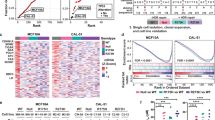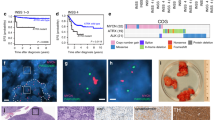Abstract
The human fibrosarcoma cell line, HT1080, clone H4, was used to determine if the transformation suppressive functions of p53 and Egr-1 have the same underlying mechanism. This cell line expresses only mutant p53 and no detectable Egr-1. H4 clones stably expressing Egr-1 are less transformed in proportion to the level of Egr-1 expressed, acting through the induction of the TGFβ1 gene. Here, H4 cells and the highest Egr-1 expressing clone were transfected with a vector expressing normal human p53 to derive stable clones expressing p53. The expression of p53 in H4 cells inhibited transformed growth and reduced tumorigenicity. The effect of co-expression of both p53 and Egr-1 was additive, producing cell lines with 30% of normal growth rate and sevenfold reduced tumorigenicity compared with control lines. These results indicated that each factor may act independently by different pathways, although each additively increased the level of p21WAF1 cell cycle inhibitor. However, exposure of the H4-derived cells to UV-C irradiation produced contrasting effects. Cell cycle analyses showed that the presence of p53 was associated with loss of the G1 and S cells to apoptosis after irradiation. In contrast, the expression of Egr-1 increased entry into S/G2 phase of the cell cycle with little apoptosis via a mechanism involving elevated FAK and low caspase activities. Apoptosis was observed only in the cell lines that expressed no Egr-1, especially those expressing wt-p53, and was preceded by high caspase activity. In summary, Egr-1 suppressed transformation and counteracted apoptosis by the coordinated activation of TGFβ1, FN, p21 and FAK, leading to enhanced cell attachment and reduced caspase activity. In the doubly expressing cell line, the survival effect of Egr-1 was dominant over the apoptotic effect of p53.
This is a preview of subscription content, access via your institution
Access options
Subscribe to this journal
Receive 50 print issues and online access
$259.00 per year
only $5.18 per issue
Buy this article
- Purchase on Springer Link
- Instant access to full article PDF
Prices may be subject to local taxes which are calculated during checkout









Similar content being viewed by others
Abbreviations
- FACS:
-
fluorescence-activated cell sorting
- FAK:
-
focal adhesion kinase
- FN:
-
fibronectin
- JNK:
-
jun kinase
- PBS:
-
phosphate buffered saline
- PAI-1:
-
plasminogen activator inhibitor-1
- TGFβ:
-
transforming growth factor β
References
Ahmed MM, Venkatasubbarao K, Fruitwala SM, Muthukkumar S, Wood Jr DP, Sells SF, Mohiuddin M and Rangnekar VM. . 1996 J. Biol. Chem. 271: 29231–29237.
Ahmed MM, Sells SF, Venkatasubbarao K, Fruitwala SM, Muthukkumar S, Harp C, Mohiuddin M and Rangnekar VM. . 1997 J. Biol. Chem. 272: 33056–33061.
Akagi M, Yasui W, Akama Y, Yokozaki H, Tahara H, Haruma K, Kajiyama G and Tahara E. . 1996 Jap. J. Cancer Res. 87: 377–384.
Akamatsu H, Ichihara-Tanaka K, Ozono K, Kamiike W, Matsuda H and Sekiguchi K. . 1996 Cancer Res. 56: 4541–4546.
Baker SJ, Markowitz S, Fearon ER, Willson JK and Vogelstein B. . 1990 Science 249: 912–915.
Chang YC, Lee YS, Tejima T, Tanaka K, Omura S, Heintz NH, Mitsui Y and Magae J. . 1998 Cell Growth Diff. 9: 79–84.
Del Sal G, Murphy M, Ruaro E, Lazarevic D, Levine AJ and Schneider C. . 1996 Oncogene 12: 177–185.
Deveraux QL, Takahashi R, Salvesen GS and Reed JC. . 1997 Nature 388: 300–304.
Diller L, Kassel J, Nelson CE, Gryka MA, Litwak G, Gebhardt M, Bressac B, Ozturk M, Baker SJ and Vogelstein B and Friend SH. . 1990 Mol. Cell. Biol. 10: 5772–5781.
Dinkel A, Aicher WK, Haas C, Zipfel PF, Peter HH and Eibel H. . 1997 J. Immunol. 159: 2678–2684.
El-Deiry WS, Tokino T, Velculescu VE, Levy DB, Parsons R, Trent JM, Lin D, Mercer WE, Kinzler KW and Vogelstein B. . 1993 Cell 75: 817–825.
El-Deiry WS, Harper JW, O'Connor PM, Velculescu VE, Canman C, Jackman J, Pietenpol JA and Burrell M, Hill DE, Wang Y, Wiman KG, Mercer WE, Kastan MB, Kohn KW, Elledge SJ, Kinzler KW and Vogelstein B. . 1994 Cancer Res. 54: 1169–1174.
Frisch SM. . 1994 J. Cell. Biol. 127: 1085–1096.
Frisch SM and Francis H. . 1994 J. Cell. Biol. 124: 619–626.
Frisch SM. . 1996 Mutation Research 350: 261–266.
Frisch SM, Vuori K, Ruoslahti E and Chan-Hui PY. . 1996 J. Cell. Biol. 134: 793–799.
Fuchs EJ, McKenna KA and Bedi A. . 1997 Cancer Res. 57: 2550–2554.
Gervais JL, Seth P and Zhang H. . 1998 J. Biol. Chem. 273: 19207–19212.
Globus RK, Doty SB, Lull JC, Holmuhamedov E, Humphries HJ and Damsky CH. . 1998 J. Cell Sci. 111: 1385–1393.
Hallahan DE, Dunphy E, Virudachalam S, Sukhatme VP, Kufe DW and Weichselbaum RR. . 1995 J. Biol. Chem. 270: 30303–30309.
Hibi M, Lin A, Smeal T, Minden A and Karin M. . 1993 Genes Dev. 7: 2135–2148.
Huang R-P, Darland T, Okamura D, Mercola D and Adamson ED. . 1994a Oncogene 9: 1367–1377.
Huang R-P, Ngo L, Okamura D, Tucker M and Adamson ED. . 1994b J. Cell. Biochem. 56: 469–479.
Huang RP and Adamson ED. . 1995 Oncogene 10: 467–475.
Huang R-P, Liu C-T, Fan Y, Mercola DA and Adamson ED. . 1995 Cancer Res. 55: 5054–5062.
Huang R-P, Wu J-X, Fan Y and Adamson ED. . 1996 J. Cell Biol. 133: 211–220.
Huang R-P, Fan Y, de Belle I, Niemeyer C, Gottardis MM, Mercola D and Adamson ED. . 1997 Int. J. Cancer 72: 102–109.
Huang R-P, Fan Y, Ni Z-Y, Matheny W and Adamson ED. . 1998a Cell Death and Diff. 5: 96–106.
Huang R-P, Fan Y, Peng A, Reed JC, Adamson ED and Boynton AL. . 1998b Int J. Cancer 77: 880–886.
Hungerford JE, Compton MT, Matter ML, Hoffstrom BG and Otey CA. . 1996 J. Cell. Biol. 135: 1383–1390.
Keyse SM. . 1993 Sem. Cancer Biol. 4: 119–128.
Kieser A, Seitz T, Adler HS, Coffer P, Kremmer E, Crespo P, Gutkind JS, Henderson DW, Mushinski JF, Kolch W and Mischak H. . 1996 Genes Dev. 10: 1455–1466.
Landesman Y, Bringold F, Milne DD and Meek DW. . 1997 Cellular Signalling 9: 291–298.
Levine AJ, Chang A, Dittmer D, Notterman DA, Silver A, Thorn K, Welsh D and Wu M. . 1994 J. Lab Clin. Med. 123: 817–823.
Levine AJ. . 1997 Cell 88: 323–331.
Liebermann DA, Hoffman B and Steinman RA. . 1995 Oncogene 11: 199–210.
Lin J, Wu X, Chen J, Chang A and Levine AJ. . 1994 Cold Spring Harb. Symp. Quant. Biol. 59: 215–223.
Liu C, Adamson E and Mercola D. . 1996 Proc. Natl. Acad. Sci. USA 93: 11831–11836.
Liu C, Yao J, de Belle I, Huang R-P, Adamson ED and Mercola D. . 1999 J. Biol. Chem. 274: 4400–4411.
Madden SL, Galella EA, Zhu JS, Bertelsen AH and Beaudry GA. . 1997 Oncogene 15: 1079–1085.
Merlo GR, Venesio T, Taverna D, Marte BM, Callahan R and Hynes NE. . 1994 Oncogene 9: 443–453.
Mohiuddin M, Ahmed MM, Venkatasubbarao K, Fruitwala S, Rangnekar V, Cross P and Weinstein M. . 1997 Proc. Amer. Ass. Cancer Res. 38: 427.
Muthukkumar S, Nain P, Sells SF, Maddiwar NG, Jacob RJ and Rangnekar VM. . 1995 Mol. Cell Biol. 15: 6262–6272.
Muthukkumar S, Han SS, Rangnekar VM and Bondada S. . 1997 J. Biol. Chem. 272: 27987–27993.
Nair P, Muthukkumar S, Sells SF, Han SS, Sukhatme VP and Rangnekar VM. . 1997 J. Biol. Chem. 272: 20131–20138.
Nguyen HO, Hoffman-Libermann B and Liebermann DA. . 1993 Cell 72: 197–209.
Park DS, Stefanis L, Yan CYI, Farinelli SE and Greene LA. . 1996 J. Biol. Chem. 271: 21898–21905.
Park JA, Kim KW, Kim S and Lee SK. . 1998 Eur. J. Biochem. 257(1): 242–248.
Perry ME and Levine AJ. . 1993 Curr. Opin. Genet. Dev. 3: 50–54.
Planus E, Barlovatz-Meimon G, Rogers RA, Bonavaud S, Ingber DE and Wang N. . 1997 J. Cell Sci. 110: 1091–1098.
Sabbatini P, Lin J, Levine AJ and White E. . 1995 Genes. Dev. 9: 2184–2192.
Scott G, Cassidy L and Busacco A. . 1997 J. Invest. Dermatol. 108(2): 147–153.
Selvakumaran M, Lin HK, Miyashita T, Wang HG, Krajewski S, Reed JC, Hoffman B and Liebermann D. . 1994 Oncogene 9: 1791–1798.
Smith ML, Chen IT, Zhan Q, O'Connor PM and Fornace Jr AJ. . 1995 Oncogene 10: 1053–1059.
Sukhatme VP, Cao X, Chang LC, Tsai-Morris C-H, Stamenkovitch D, Ferreira PCP, Cohen DR, Edwards SA, Shows TB, Curran T, Le Beau MM and Adamson ED. . 1988 Cell 53: 37–43.
Weichselbaum RR, Hallahan D, Fuks Z and Kufe D. . 1994 Int. J. Radiat. Oncol. Biol. Phys. 30: 229–234.
Wen LP, Fahrni JA, Troie S, Guan JL, Orth K and Rosen GD. . 1997 J. Biol. Chem. 272: 26056–26061.
Wu L and Levine AJ. . 1997 Mol. Med. 3: 441–451.
Xiong WC and Parsons JT. . 1997 J. Cell. Biol. 139: 529–539.
Xu LH, Owens LV, Sturge GC, Yang X, Liu ET, Craven RJ and Cance WG. . 1996 Cell Growth Diff. 7: 413–418.
Zhang Z, Vuori K, Reed JC and Ruoslahti E. . 1995 Proc. Natl. Acad. Sci. USA 92: 6161–6165.
Acknowledgements
We thank our colleagues at the Burnham Institute, S Frisch, A Marti, JC Reed, I Tamm and X Zhang, for gifts of antibodies, for advice and for critical comments on the manuscript. We are indebted to B Vogelstein and J Trill for plasmids, and to JT Parsons for antibodies to PYK-2. We are grateful for support from the Public Health Services, grant CA 67888 (ED Adamson), CA 63783 and CA76173, (D Mercola) from the National Cancer Institute.
Author information
Authors and Affiliations
Rights and permissions
About this article
Cite this article
de Belle, I., Huang, RP., Fan, Y. et al. p53 and Egr-1 additively suppress transformed growth in HT1080 cells but Egr-1 counteracts p53-dependent apoptosis. Oncogene 18, 3633–3642 (1999). https://doi.org/10.1038/sj.onc.1202696
Received:
Revised:
Accepted:
Published:
Issue Date:
DOI: https://doi.org/10.1038/sj.onc.1202696
Keywords
This article is cited by
-
N6-methyladenosine reader YTHDF2 promotes multiple myeloma cell proliferation through EGR1/p21cip1/waf1/CDK2-Cyclin E1 axis-mediated cell cycle transition
Oncogene (2023)
-
Upregulation of ERK-EGR1-heparanase axis by HDAC inhibitors provides targets for rational therapeutic intervention in synovial sarcoma
Journal of Experimental & Clinical Cancer Research (2021)
-
TBX2 interacts with heterochromatin protein 1 to recruit a novel repression complex to EGR1-targeted promoters to drive the proliferation of breast cancer cells
Oncogene (2019)
-
Molecular targets and signaling pathways regulated by nuclear translocation of syndecan-1
BMC Cell Biology (2017)
-
The expression of B23 and EGR1 proteins is functionally linked in tumor cells under stress conditions
BMC Cell Biology (2015)



